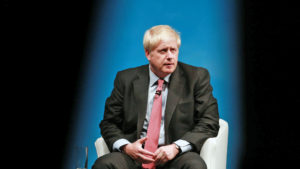Boris Johnson stands over your hospital bed, mask and medical gown on, forceps at hand, shining a lamp brightly down on your face. There had better be a good reason you’re undergoing this surgery. Pain must have a purpose.
Think back to the early Eighties. We face many of the same pains, again under a Conservative-majority government: Moscow is in the news for all the wrong reasons; high inflation; low growth; widespread industrial action. Britain is a country ill-at-ease, uncertain of its next destination.
The surgeon back then had no uncertainty over what medicine needed to be administered, what operation was required. The 1979 election was a referendum over the direction of the country: more of the same pain, or an operation that, despite its risks, might just jolt the country back to life?
And while you could describe both Conservative prime ministers by their characterful hair alone — Margaret Thatcher: powerful, unyielding, strong; Boris Johnson: chaotic, untidy, silly — there the similarities quickly come to an end. This hasn’t stopped the Johnson cabinet claiming the Thatcher legacy as its own. Hear Rishi Sunak’s speeches and you would assume the Government was on a Lawsonian crusade against high taxes.
The reality is precisely the opposite: taxes are about to reach their highest level since the Second World War, 12 years after the tax-cutting Tories re-entered Number 10. In 1979, the party swept into government with a clear diagnosis and a comprehensive treatment plan, defined by its ambition to bring down inflation, get Britain back on track, and consign the “sick man of Europe” label to the dustbin.
Today, however, after three consecutive Tory prime ministers, the party seems tired and unsure of what the whole point of being in government is, beyond holding power for its own sake. The by-election results from Wakefield and Tiverton will all but confirm this, covering two completely different demographics and geographies. The likely defeats will be a symptom of the lack of a narrative that holds the Government together — unlike Thatcher’s crusade against inflation, excessive union power, and unfree markets delivering poor outcomes to consumers.
Ostensibly, Levelling Up is the Government’s mission. But with limited cash or ideological rigour underpinning the policy, claims of ambition, drive and determination ring hollow. It didn’t seem this way two-and-a-half years ago, when the party jettisoned austerity and set sail for new ideological waters. What was remarkable, and remarked upon heavily after the 2019 landslide win, was how far the Tories had reached into former Labour heartlands. Wakefield itself is a prime example of one of these “Red Wall” constituencies. For the first time in generations, it bought into a Tory aspirational narrative. These areas were going to get better, and the Conservatives were going to be the party to make that happen.
But what wasn’t sufficiently remarked upon at the time was the extent to which this victory was achieved without the youth of Britain’s cities. Instead, it was achieved with a deep dependence on older voters, with over two-thirds of people in their seventies and over voting Tory.
It is easy to imagine that the cities, London in particular, have always been bastions of falafel-eating, Birkenstock-wearing liberals — impregnable Red fortresses owned by the Labour Party since time immemorial. Yet that is to forget that Thatcher’s majorities were achieved with the enthusiastic support of the cities. In London, a full two-thirds of the seats were won by the Conservative party in 1983, compared with only 29% in 2019. By contrast, the 2019 victory was underpinned not by a vision of growth and ambition, but by home-owning pensioners in ex-industrial and ex-mining regions who didn’t usually vote Conservative for cultural reasons, but finally snapped and voted for their own interests.
The traditional diagnosis for the cities turning against the Conservatives is that this split has happened over social and cultural values. Cities are predominantly young, and the young reject the current social and cultural values of the Conservative Party: values typified by the placement of Nadine Dorries as culture secretary, initiatives such as the Rwanda refugee resettlement policy led by home secretary, Priti Patel, and, of course, Brexit.
While this is certainly a significant part of the picture, what is rarely accounted for is the wholesale fiscal and monetary contempt the modern Tory Party has for anyone who isn’t a home-owning pensioner. Faced with the highest tax burden since the war, the highest inflation in decades, and ever-shifting student loan repayment terms — faced with plummeting rates of homeownership and sky-high house prices that have more than sextupled the time it takes for someone in their late-twenties to save a deposit — why should anyone under-40 vote for the Conservative Party?
And for retirees? As much jam as they want. Pensioner incomes now even exceed working incomes, after tax and housing costs, for the first time in history. The United Kingdom is choosing not to reward those who are building for the future. Instead, the spoils of the Treasury are being diverted to the mediocrity of the already satisfied, whose biggest ambition is driving their Honda Jazz to the local garden centre to buy a plastic lawn they won’t have to bother mowing.
This wasn’t always the case. Once upon a time, at an archetypal and electoral level, the urban yuppie seemed the core demographic of the Conservative Party: young chaps with floppy hair in pinstripe suits striding confidently through the City with ears glued to a mobile telephone the size of a small dog, shouting “Buy buy buy!” These aspirational workers could not have been more enthusiastic for the Thatcherite deregulation of the financial markets and the Lawson tax-cutting budgets.
What changed? Simply put, the core value of the Conservative Party is not deregulation, low taxation or free markets. The core value is power.
This is not necessarily a bad thing. Being in government means weilding the ability to shape the country in your image and, just as important, prevent the opposition from shaping it in theirs. But what happens if access to power is shaped not by the distribution of “winners and losers” in society, where pressure builds up over time in living conditions to shift voting behaviour, but by the sheer size of a demographic cohort?
The clue is in the name — baby boomers. The huge increase in post-war births resulted in a great demographic bulge. There are millions more baby boomers than in the following and preceding population cohorts. This has granted baby boomers the advantage of a vast, unified voting bloc. This bloc of voters, owing to their similar age, wealth and health needs, are all likely to have comparable public spending and policy priorities.
With this voting power comes responsibility. But like a Labrador with access to an unlimited supply of sausages, the boomer cohort has not been able to help itself — and has gorged itself until it can barely walk. The triple lock on pensions; ring-fenced NHS and social care spending; low taxation on asset wealth owned by the old, combined with high taxation on income, predominantly earned by the young; avoidance of housing reform. And austerity? That was for the young only.
“The facts of life are Conservative,” said Thatcher. And broadly, it holds true. People like to limit the rate of change in their communities. And once people have built assets, they want to see them protected, and taxed lightly, if at all. But what if people can’t even build an asset base in the first place, because of a combination of planning gridlock and loose monetary policy shooting house prices into the stratosphere? What if they remain vagabonds, moving from rental flat to rental flat, not gaining a sense of community to care about, enrich and protect?
Think back to the ambition of the Right to Buy policy. The politics of enabling homeownership to a generation of striving workers wasn’t lost on the party then. It was a central policy of the government: an opportunity for the aspirant individual to buy into the national project. The party has since betrayed its own orthodoxies for political convenience and power. But through this it has set a potentially terminal trap for itself. If the facts of life are no longer conservative, how can the party build a winning coalition? As the boomer demographic declines, all the party will be left with is a generation of resentful, asset-poor millennials who haven’t seen income growth in decades.
The next election is already looming over this parliament, and the need for a radical policy agenda to challenge this inequality is glaring. Young people already overwhelmingly vote against the Conservative Party, which barely mustered a fifth of the 18-29 vote share in 2019, a year in which it won a landslide victory. Labour already can already rely on this demographic. All that’s left for Labour to go after — which means favourable policies, subsidy and controversy avoidance — is the predominantly Conservative boomer vote. Politics by traffic jam. Pork barrel politics divided by age, not by constituency.
Despite this grim outlook, green shoots of ideological rebellion are emerging within Conservative circles. Innovative policy solutions such as Policy Exchange’s Street Votes proposal are being laid down. The party may also seek to focus on building in the cities over the more politically controversial areas with housing shortages in more rural areas. The political risk here is much diminished. What will the heavily Labour city constituencies do if they hate development — vote more heavily against the party that doesn’t hold their seat?
Others in the party are also questioning treasury orthodoxy on investment spending. Abandoned to the Brownites in the 2010s, a perfectly reasonable conservative case can be made for state-spending on infrastructure to lower taxes in the long run because of higher economic growth. The party of business cannot be blind to the fact that businesses require investment to grow and become profitable. If this idea was good enough for Ronald Reagan’s Right-leaning government, it can be good enough for the Tories today.
For now, however, these remain fringe ideas within the party. The discontent is there, and it’s growing, driven by high prices, a decade of stagnant growth and limited policy innovation. If it’s to move forward, the party needs to admit to itself the scale of the ideological tangle it’s got itself into. The national pallor of the late Seventies forced a brave, ideological character to emerge in the form of Thatcher.
Today, after 12 long, tiring years in power, no such figure has emerged. And that doesn’t look like changing. Whether the Wakefield and Tiverton by-elections will serve as a second trigger for leadership challenges is unclear, even with the year-long immunity from a confidence vote that is assured by the 1922 Committee rules. It would only take a rule change from the committee to see Johnson fall. Either way, today’s polls surely mark the beginning of the end of the Johnson era.
Who will follow is anyone’s guess, though it seems likely they will disappoint. After all, which Tory will be brave enough to challenge, let alone destroy, the boomer-led satisfaction with national mediocrity?
Disclaimer
Some of the posts we share are controversial and we do not necessarily agree with them in the whole extend. Sometimes we agree with the content or part of it but we do not agree with the narration or language. Nevertheless we find them somehow interesting, valuable and/or informative or we share them, because we strongly believe in freedom of speech, free press and journalism. We strongly encourage you to have a critical approach to all the content, do your own research and analysis to build your own opinion.
We would be glad to have your feedback.
Source: UnHerd Read the original article here: https://unherd.com




